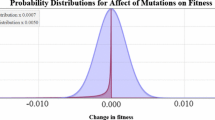Abstract
Using a three-locus model wherein two loci regulate a third, candidate locus, I examine physiological epistasis from the ‘gene's eye view’ of the regulated locus. I show that, depending upon genetic background at the regulatory loci, an allele at the candidate locus can be dominant, additive, recessive, neutral, over-dominant, or under-dominant in its effects on fitness. This kind of variation in allelic effect caused by variation in genetic background from population to population, from time to time in the same population, or sample to sample makes finding and mapping the genes underlying a complex phenotype difficult. The rate of evolution of such genes can also be slowed, especially in genetically subdivided metapopulations with migration. Nevertheless, understanding how variation in genetic background causes variation in allelic effects permits the genetic architecture of such complex traits to be dissected into the interacting component genes. While some backgrounds diminish allelic effects and make finding and mapping genes difficult, other backgrounds enhance allelic effects and facilitate gene mapping.
Similar content being viewed by others
References
Clark, A.G. & L. Wang, 1997. Epistasis in measured genotypes: Drosophila P-element insertions. Genetics 147: 157–163.
Crow, J.F. & M. Kimura, 1970. An Introduction to Population Genetics Theory. Burgess Publishing Company, Minneapolis, MN.
Czeizel, A., 1989. Application of DNA analysis in diagnosis and control of human diseases. Biol. Zentrabl. 108: 295–301.
Eaves, L.J., 1994. Effect of genetic architecture on the power of human linkage studies to resolve the contribution of quantitative trait loci. Heredity 72: 175–192.
Falconer, D.S. & T.F.C. Mackay, 1996. Introduction to Quantitative Genetics. Longman, NY.
Fedorowicz, G.M., J.D Fry, R.R.H. Anholt & T.F.C. Mackay, 1998. Epistatic interactions between smell-impaired loci in Drosophila melanogaster. Genetics 148: 1885–1891.
Frank, S.A., 1999. Population and quantitative genetics of regulatory networks. J. Theor. Biol. 197: 281–294.
Gallais, A. & M. Rives, 1993. Detection, number and effects of QTLs for a complex character. Agronomie 13: 723–738.
Gurganus M.C., S.V. Nuzhdin, J.W. Leips & T.F.C. Mackay, 1999. High-resolution mapping of quantitative trait loci for sternopleural bristle number in Drosophila melanogaster. Genetics 152: 1585–1604.
Johnson, N. & A.H. Porter, 2000. Rapid speciation via parallel, directional selection on regulatory genetic pathways. J. Theor. Biol. 205: 527–542.
Johnson, N. & A.H. Porter, 2001. Toward a new synthesis: population genetics and evolutionary developmental biology. Genetica: 112-113: 45–58.
Matioli, S.R. & A.R. Templeton, 1999. Coadapted gene complexes for morphological traits in Drosophila mercatorum: two-loci interactions. Heredity 83: 54–61.
Mackay, T.F.C. & J.D. Fry, 1996. Polygenic mutation in Drosophila melanogaster: genetic interactions between selection lines and candidate trait loci. Genetics 144: 671–688.
Marsh, D.G., J.D. Neeley, D.R. Breazeale, B. Ghosh, L.R. Friedhoff, E. Ehrlichkautzky, C. Schou, G. Krishnaswamy & T.H. Beaty, 1994. Linkage analysis of IL-4 and other chromosome 5Q31.1 markers and total serum immunoglobulin-E concentrations. Science 264: 1152–1156.
Ridley, M., 2000. Asthma, environment, and the genome. Natur. His. 109: 54–65.
Schlichting, C.D. & M. Pigliucci, 1998. Phenotypic Evolution: A Reaction Norm Perspective. Sinauer Associates, MA.
Starmer, W.T., M. Polak, L.L. Wolf & J.S.F. Barker, 1998. Reproductive characteristics of the flower breeding Drosophila hibisci back (Drosophilidae) in eastern Australia: genetic and environmental determinants of ovariole number. Evolution 52: 806–815.
Templeton A.R., 1980. The theory of speciation via the founder principle. Genetics 94: 1011–1038.
Templeton, A.R., 1995. A cladistic analysis of phenotypic associations with haplotypes inferred restriction endonuclease mapping or DNA sequencing. V. Analysis of case/control sampling designs: Alzheimer' disease and the Apoprotein E locus. Genetics 140: 403–409.
Templeton, A.R., 2000. Epistasis and the Evolutionary Process, edited by J.B. Wolf, E.D. Brodie III & M.J. Wade. Oxford University Press, NY.
von Dassow, G., E. Meir, E.M. Munro & G.M. Odell, 2000. The segment polarity network is a robust developmental module. Nature 406: 188–192.
Wade, M.J., 2000. Epistasis as a genetic constraint within populations and an accelerant of adaptive divergence among them, pp. 213–231 in Epistasis and the Evolutionary Process, edited by J.B. Wolf, E.D. Brodie III & M.J. Wade. Oxford University Press, NY.
Wade, M.J. & C.J. Goodnight, 1999. Perspective: the theories of Fisher and Wright in the context of metapopulations: when nature does many small experiments. Evolution 52:1537–1553.
Whitlock, M.C., 1992. Nonequilibrium population structure in forked fungus beetles: extinction, colonization, and the genetic variance among populations. Am. Natural. 139: 952–970.
Wolf, U., 1997. Identical mutations and phenotypic variation. Hum. Genet. 100: 305–321.
Author information
Authors and Affiliations
Rights and permissions
About this article
Cite this article
Wade, M.J. Epistasis, complex traits, and mapping genes. Genetica 112, 59–69 (2001). https://doi.org/10.1023/A:1013316611768
Issue Date:
DOI: https://doi.org/10.1023/A:1013316611768




